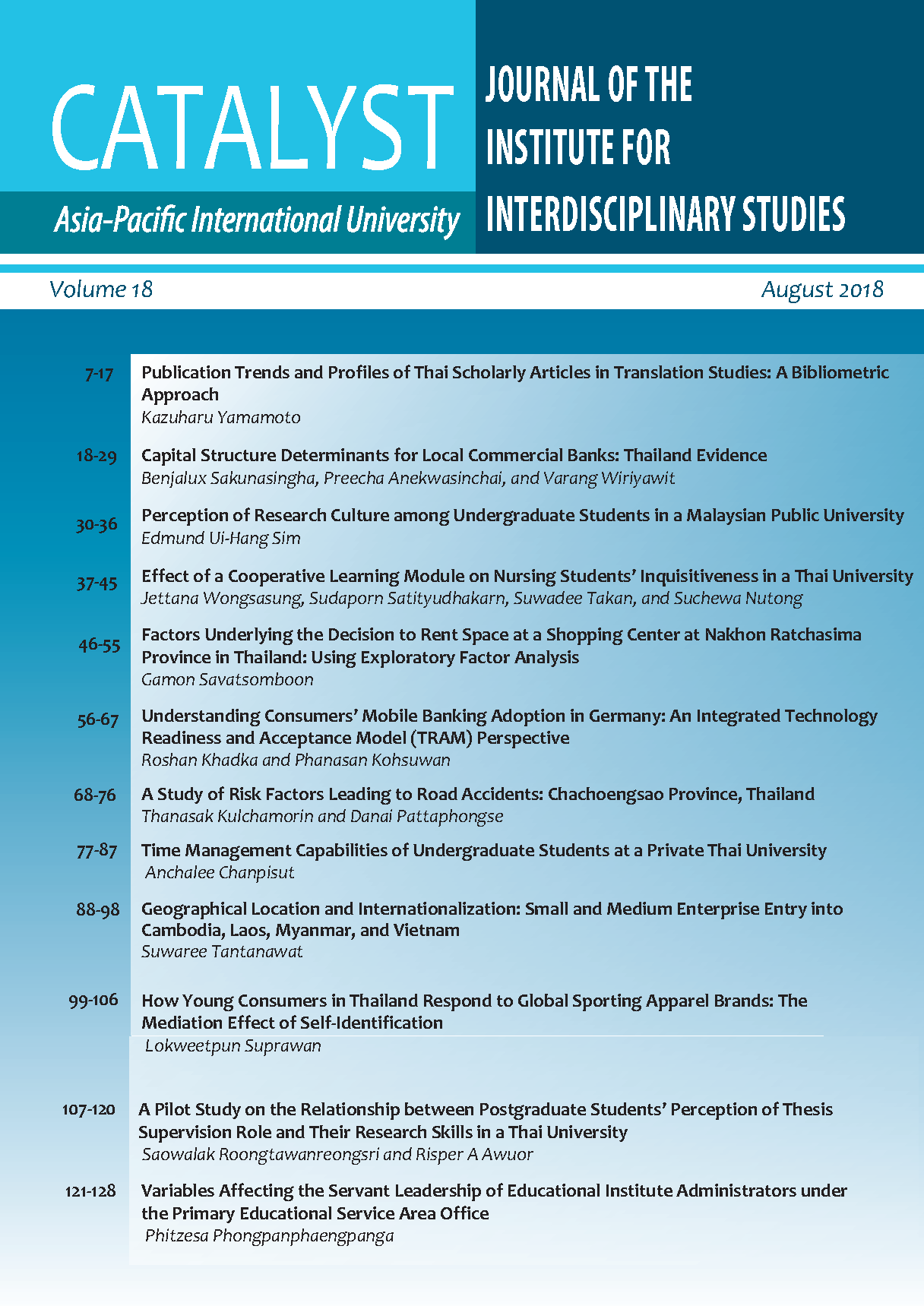Geographical Location and Internationalization: Small and Medium Enterprise Entry into Cambodia, Laos, Myanmar, and Vietnam
Main Article Content
Abstract
Porter (2000) proposed the notion of location as a competitive advantage, a way to generate advantages for regions, nations, and even firms. Small and Medium Enterprises (SMEs) are one factor in the quest to pursue national prosperity. SMEs may create competitive advantages for countries as well as at the regional level, a point that is understood by the Association of Southeast Asian Nations (ASEAN) even though public sector support for SMEs is very limited, especially in the internationalization process. Lack of consistent policy initiation and implementation has led to uncertainty for business firms. The CLMV region consisting of Cambodia, Laos, Myanmar, and Vietnam is an area that other ASEAN members may explore to find opportunities for international market expansion. This paper highlights factors that influence the internationalization process in respect to the competitiveness of location. The proposed model identifies factors that influence international market expansion, which include product competitive advantage and firm characteristics. These influences are moderated by market accessibility, financial resources, innovation, and networking. The paper also suggests several propositions intended to increase the effectiveness of the internationalization process for SMEs that are interested in regional expansion.
Article Details

This work is licensed under a Creative Commons Attribution-NonCommercial-NoDerivatives 4.0 International License.
Copyright: Asia-Pacific International University reserve exclusive rights to publish, reproduce and distribute the manuscript and all contents therein.
References
Basly, S. (2007). The internationalization of family SME: An organizational learning and knowledge development perspective. Baltic Journal of Management, 2(2), 154-180.
Berry, H., Guillén, M., & Zhou, N. (2010). An institutional approach to cross-national distance. Journal of International Business Studies, 41(9), 1460-1480.
Boter, H., & Lundström, A. (2005). SME perspectives on business support services: The role of company size, industry and location. Journal of Small Business and Enterprise Development, 12(2), 244-258.
Chheang, V., & Wong, Y. (2012). Cambodia-Laos-Vietnam: Economic Reform and Regional Integration. Retrieved from http://www.aseancenter.org.tw/upload/files/201209073-1.pdf.
Cort, K. T., Griffith, D. A., & Steven White, D. (2007). An attribution theory approach for understanding the internationalization of professional service firms. International Marketing Review, 24(1), 9-25.
Delgado, M., Ketels, C., Porter, M., & Stern, S. (2012). The determinants of national competitiveness (No. w18249). National Bureau of Economic Research: Cambridge, MA, USA.
Fernhaber, S., Gilbert, B., & McDougall, P. (2008). International entrepreneurship and geographic location: an empirical examination of new venture internationalization. Journal of International Business Studies, 39(2), 267-290.
Fornes, G., Cardoza, G., & Xu, S. (2012). The national and international expansion of Chinese SMEs: evidence from Anhui Province. Journal of Chinese Entrepreneurship, 4(3), 221-242.
Gjellerup, P. (2000), “SME support services in the face of globalization”, concerted action seminar, Opening address, Conference Proceedings, Danish Agency for Trade and Industry, Copenhagen, pp. 16-28.
Hall, C. (2003). The SME policy framework in ASEAN and APEC: Benchmark comparisons and analysis. Paper presented at the Small Enterprise Association of Australia and New Zealand 16th Annual Conference, Ballarat (Vol. 28).
Hitt, M. (2016). International strategy and institutional environments. Cross Cultural & Strategic Management, 23(2), 206-215.
Hlaing, N. (2014). The review and evaluation of industrial policy especially SMEs development of CLMV countries. ASEAN-Canada Research Partnership Working Paper Series, (6).
Hofstede, G. (2003). Culture's consequences: Comparing values, behaviors, institutions and organizations across nations. Thousand Oaks, CA: Sage Publications.
Indrawati, S. (2012). SME's Product Investment Priority and Selection Based on Local Competencies. Procedia Economics and Finance, 4, 59-67.
Lim, H., & Kimura, F. (2009, July). The internationalization of SMEs in regional and global value chains. In LAEBA Conference on Accelerating Regional Integration in the Asia-Pacific Region (Vol. 15).
Lucky, E. (2012). The joint moderating effect of location and culture on small firm performance. International Journal of Academic Research in Business and Social Sciences, 2(1), 324-340.
Marchi, G., Vignola, M., Facchinetti, G., & Mastroleo, G. (2014). International market selection for small firms: A fuzzy-based decision process. European Journal of Marketing, 48(11/12), 2198-2212.
Mazzarol, T., & Choo, S. (2003). A study of the factors influencing the operating location decisions of small firms. Property Management, 21(2), 190-208.
Minai, M. & Lucky, E. (2011). The moderating effect of location on small firm performance: Empirical evidence. International Journal of Business and Management, 6(10), 178.
Parnell, J. (2006). Generic strategies after two decades: a reconceptualization of competitive strategy. Management Decision, 44(8), 1139-1154.
Pinho, J. (2007). The impact of ownership: Location-specific advantages and managerial characteristics on SME foreign entry mode choices. International Marketing Review, 24(6), 715-734.
Porter, M. (1990). The competitive advantage of nations. Competitive Intelligence Review, 1(1), 1-14.
Porter, M. (2000). Location, competition, and economic development: Local clusters in a global economy. Economic Development Quarterly, 14(1), 15-34.
Ruzzier, M., Hisrich, R., & Antoncic, B. (2006). SME internationalization research: past, present, and future. Journal of Small Business and Enterprise Development, 13(4), 476-497.
Sisounonth, O., & Kongmanila, X. (2014). A study on SME development in Laos: The case of commerce sector in Vientiane Capital. International Journal of Economics and Empirical Research (IJEER), 2(5), 203-210.
Snowdon, B., & Stonehouse, G. (2006). Competitiveness in a globalized world: Michael Porter on the microeconomic foundations of the competitiveness of nations, regions, and firms. Journal of International Business Studies, 37(2), 163-175.
Smit, A. (2010). The competitive advantage of nations: is Porter’s Diamond Framework a new theory that explains the international competitiveness of countries. Southern African Business Review, 14(1), 105-130.
Wyatt, M., Pathak, S., & Zibarras, L. (2010). Advancing selection in an SME: Is best practice methodology applicable? International Small Business Journal, 28(3), 258-273.
Yiu, D., & Makino, S. (2002). The choice between joint venture and wholly owned subsidiary: An institutional perspective. Organization Science, 13(6), 667-683.


